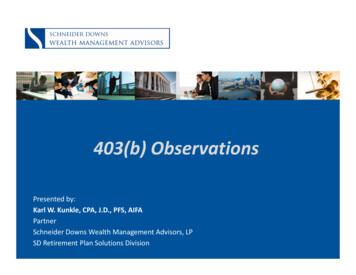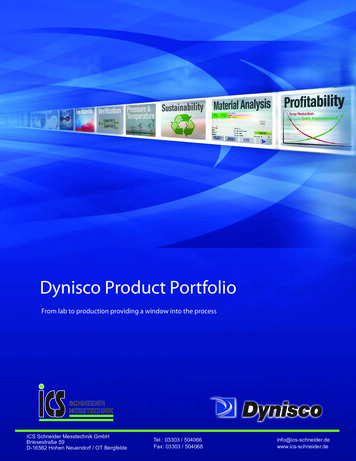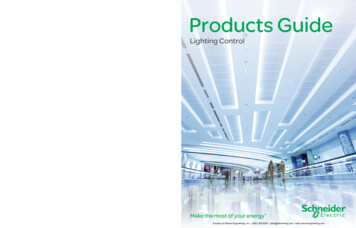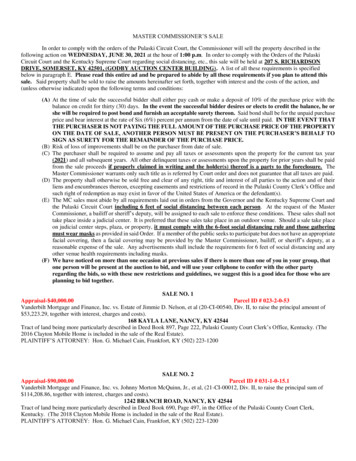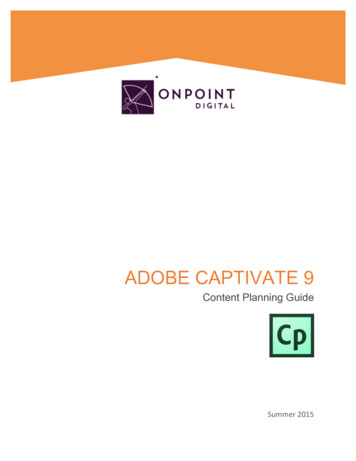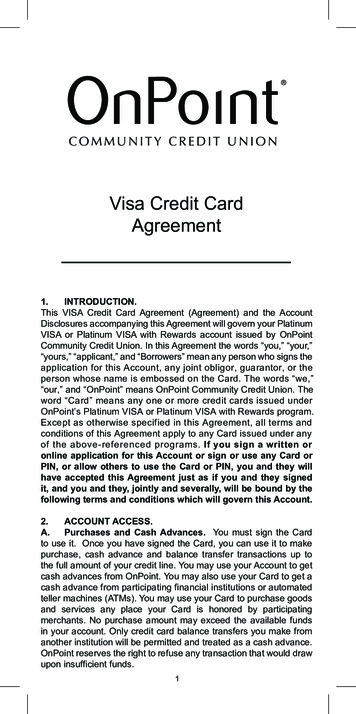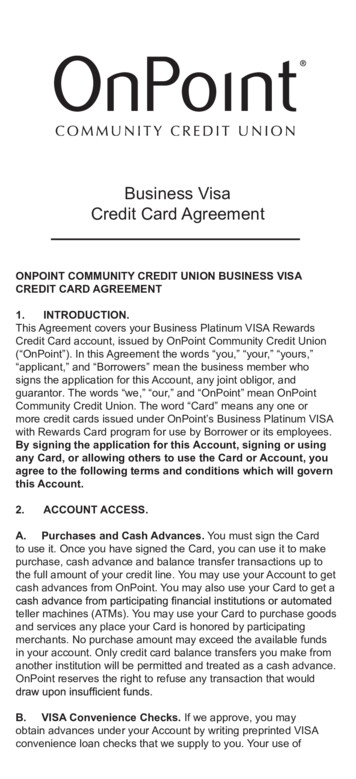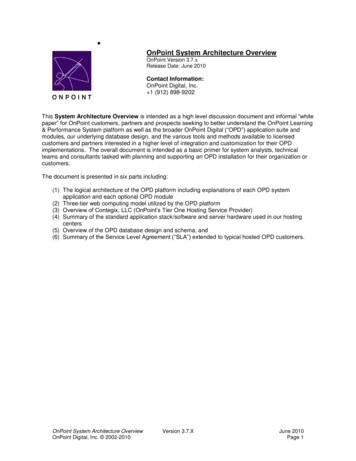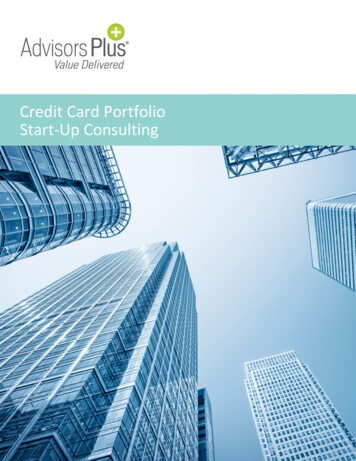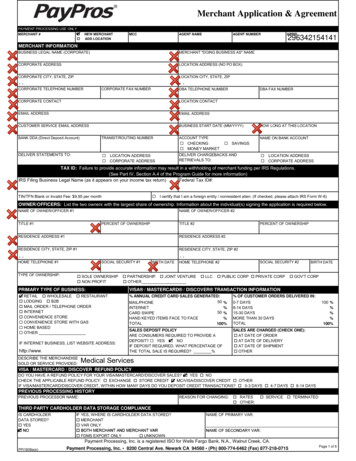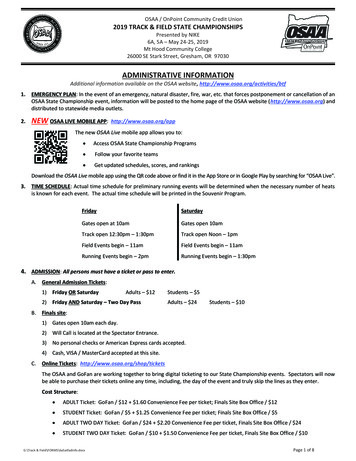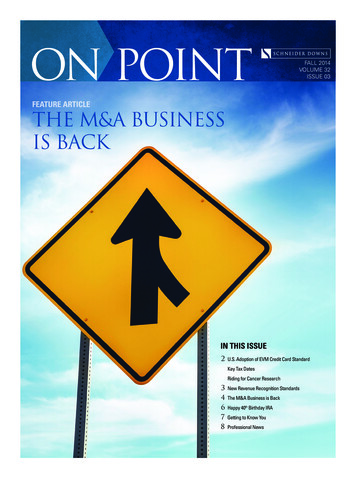
Transcription
ON POINTFALL 2014VOLUME 32ISSUE 03THE M&A BUSINESSIS BACKIN THIS ISSUE2 U.S. Adoption of EVM Credit Card StandardKey Tax DatesRiding for Cancer Research3467 8 New Revenue Recognition StandardsThe M&A Business is BackHappy 40th Birthday IRAGetting to Know YouProfessional News
K E Y TA X D AT E S10.31.2014EMPLOYERS’ TAXES. Employers of nonagriculturaland nonhousehold employees must file return onForm 941 to report income tax withholding and FICAtaxes for the third quarter of 2014.12.15.2014ESTIMATED TAX. Payment of last installment of2014 estimated tax by calendar-year corporations.1.15.2015ESTIMATED TAX. Final installment of 2014estimated tax by individuals, trust and estates andcertain residuary trusts in existence more than twoyears.Continued on Page 7RIDING FOR CANCER RESEARCHWe are proud that our first Peloton“Team Schneider Downs” consistedof 13 riders, one virtual rider, threevolunteers and countless financialsupporters throughout both offices.This small, but determined, groupsuccessfully raised over 22,200 forcancer research through work-relatedevents, community outreach andindividual fundraising. The money raisedwill be added to the Pelotonia14 total,which raised over 13,353,000 this yearand consisted of 7,270 bicycle riders.It’s also important to recognize thatPelotonia has raised over 74.4 millionfor cancer research since its inceptionin 2009.Where Does Our Money Go?The model of Pelotonia remains simple:Pelotonia’s operating expenses arecovered by the funding partners so that100% of every dollar raised by Pelotoniariders and volunteers goes directly tofund cancer research at The Ohio StateUniversity Comprehensive CancerCenter—Arthur G. James CancerHospital and Richard J. Solove ResearchInstitute.In 2008, research physician MikeCaligiuri recognized the need toexpand current funding, and proposeda grass roots cycling event in Ohio.The simple mission is to end cancerin the next three decades, and thePelotonia rallying-cry has become “OneGoalgEnd Cancer.” Between 2009 and2013, 61 million has been raised forcancer research, and their current goalis to raise 100 million over the nextfive years.A sincere thank you goes out toeveryone who supported TeamSchneider Downs this year.U.S. ADOPTION OF EMV CREDIT CARD STANDARDFor those who have travelled abroad lately,BYCHRISTOPHER DEBOyou may have noticed a difference in howTECHNOLOGY ADVISORScredit cards are constructed and processedSENIOR MANAGERat point-of-sale terminals. Adoption ofthe new EMV (Europay, MasterCard, andVisa) standard – using electronic chip-based cards instead of the traditional magneticstrip – has been rapidly growing since being introduced in 1995. Although the EMVspecifications are complex and varied (contact vs. contactless cards, tokenization), theconcept is simple: Replace the swipe-and-sign paradigm with a more secure chip-andpin architecture that requires users to have two forms of secure authentication: 1) Anencrypted electronic chip embedded in the card and 2) a pin number only known by anauthorized user of the card. Now on version 4.3, the contact-based EMV specificationis mature and has already been implemented throughout most of Europe and othercountries worldwide. And the primary benefit of EMV is easy to discern: Improvedsecurity of transactions, leading to a reduction in fraud.As it stands now, the U.S. is the last of the G-20 nations to adopt EMV technology, andit should come as no surprise that almost half of the world’s credit card fraud occurs inAmerica. So why is the U.S. lagging so far behind its modern counterparts? The answeris simple: Cost. According to a study from Javelin Strategy & Research, the cost to U.S.merchants to implement EMV will be 2.6 billion, with some 1.2 billion cards and 12million point-of-sale terminals requiring updates to be EMV-enabled. Rather than absorbthe costs of implementing EMV nationwide, merchants are willing to accept the hugelosses associated with magnetic card fraud. This is in spite of evidence showing theimpact that the introduction of EMV cards can have. Since implementing the chip-and-PINarchitecture in 2004, face-to-face card fraud has declined by 69% in the United Kingdomand 50% in France (source: The Observatory for Payment Card Security).This is set to change in 2015. In the United States, all non-petroleum MasterCardmerchants must be able to process EMV cards by October of 2015 (petroleum merchantshave until 2017). If the merchant is unable to accept EMV cards and allows consumersto use magnetic strip cards as a form of payment, they could be held liable for anysubsequent fraud committed with the card. Due to the increased level of security offeredby EMV cards, banks and credit card issuers have been shifting liability to merchants forany fraud resulting from non-EMV card transactions. In the European Union, this “liabilityshift” has been in place since 2005 for MasterCard users and 2006 for Visa. So plan onmaking extra room in your wallet for the thicker EMV cards. You’ll still be signing for now,but the new system also enables the use of PIN-numbers-card issuers decide to addthem to their cards.- Mark Shumaker, Marketing Manager2
TOP STORYNEW REVENUE RECOGNITION STANDARDSby Jason L. KingBYJASON L. KINGAUDIT MANAGERThe FASB recently issued Accounting Standards Update (ASU) No.2014-09, Revenue from Contracts with Customers, in conjunctionwith a near identical pronouncement for International FinancialReporting Standards (IFRS). The issuance of these standardscompletes the long anticipated joint effort by the FASB and theIASB to improve financial reporting by creating common revenuerecognition guidance for U.S. GAAP and IFRS. This ASU will affectentities that enter into contracts with customers to transfer goodsor services and replace a plethora of industry-specific guidance.Accounting for the new standards also includes new balance sheetand income statement concepts, (i.e., contract assets and liabilitiesand transaction price), and will require significant additionaldisclosures.Industries expected to be most significantly impacted include realestate, software, telecommunications, construction, and defensecontractors. While some entities may not see a significant impactto their revenue recognition when they are required to adopt thenew revenue recognition guidance, all should start making plans toevaluate the impact of the new standards.The core principle of the new revenue recognition standards is thatan entity should recognize revenue from the transfer of goods orservices to customers in an amount that reflects the considerationto which the entity expects to be entitled in exchange for thosegoods or services. To achieve that core principle, an entity shouldapply the following steps: So how should an entity best prepare for the adoption of the newstandards? Fortunately, the standard includes several examplesto assist with implementation, and additional resources andclarifications will be on the way. While there is no magic formulafor every entity to follow, developing an inventory of contractualarrangements with customers, and designating responsibilityinternally for evaluating and developing a plan to implement thenew standards seems like a great place to start. And of course,consulting with your CPA firm early in the process is stronglyadvised.Step 1: Identify the contract(s) with a customer.Step 2: Identify the performance obligations in the contract.Step 3: Determine the transaction price.Step 4: Allocate the transaction price to the performanceobligations in the contract.Step 5: Recognize revenue when (or as) the entity satisfies aperformance obligation.For public entities, the new standards are effective for annualreporting periods beginning after December 15, 2016, includinginterim periods within that reporting period. Early application is notpermitted. For all other entities, the amendments in this ASU areeffective for annual reporting periods beginning after December15, 2017. A nonpublic entity may elect to apply this guidance inaccordance with the public entity effective date. Upon adoption,entities will be required to present prior periods retrospectively(with options to elect certain practical expedients), orretrospectively with the cumulative effect of the change recognizedat the date of initial application with enhanced disclosures.While the core principle may seem simple at first glance,developing a standard robust enough to address contracts in allindustries and situations simultaneously results in a lot of technicalguidance for everybody to wade through (much of which may beconfusing or irrelevant).Some of the more challenging technical issues include accountingfor multiple contracts with the same customer, variablecompensation arrangements, contract modifications, non-cashcompensation issues, and management estimates needed toallocate transaction prices to performance obligations.3
FEATUREBYPETER J. LIEBERMANSCHNEIDER DOWNS CORPORATE FINANCE, LPMANAGING DIRECTOR AND CHIEFCOMPLIANCE OFFICERAfter the disaster of the financial crisis in 2008 and 2009and an inconsistent, stuttering recovery through 2012,Mergers and Acquisitions markets have surged over the last12 months, generating the strongest volumes and valuationmultiples in 8 years.invest become targets, and then are obligated to take a bigacquisition premium if offered. Private equity owners, whichplan to own a business for five to seven years, are nearlyalways opportunistic about selling into a hot market andmaximizing returns.Global transaction volume was up 14% in the first halfof 2014 versus last year, according to Capital IQ. Moredramatically, the value of M&A deals announced in the firsthalf of 2014 surged 59% from the first half of 2013.Private business owners, on the other hand, have beenslower to return to the M&A market. GF Data, a researchfirm that tracks private equity statistics, suggested in anarticle earlier this year that the mindset of closely heldbusiness owners has shifted toward retaining ownershipfor a longer period of time. GF Data surmised that: ownersare more acutely aware that owning a profitable business isgood; having survived the crisis, they are more comfortablewith wealth concentrated in the business; and technologyis allowing owners to continue operating the business intolater ages.With more deals have come higher prices. Valuationmultiples in the first half of 2014 were up 10% versus thefirst half of 2013.Several conditions are driving the resurgence.Sellers are Selling AgainOver the last two years, the biggest constraint in the M&Amarkets has been lack of sellers. More recently, sellers havecome back, particularly in two sectors – public companiesand private equity. In those sectors particularly, sellers arehighly motivated by returns to shareholders and investors.Slowly growing public companies that have cash they can’tCorporations are Very Profitable and Flush with CashCompanies are still benefiting from cost and employmentcuts made during the recession of 2009 and 2010. Oncethe recovery started, the U.S. unemployment rate has notrebounded, in part, because employers found they couldgenerate the same revenue but make more money with4
THE M&A BUSINESS IS BACKby Peter J. Liebermanfewer people. That’s bad news for the unemployed, but hasmeant that cash flow for businesses that have recoveredfrom the recession is robust. The companies have built upcash reserves and paid down debt and need to find placesto invest.Slow Economic Growth Equals Slow Organic GrowthIn spite of all those profits, organic revenue growth hasbeen challenging to generate outside of hot sectors likeenergy and health care. This is particularly true for traditionalmanufacturers that rely on broad based economic growth.As a result, corporations need to buy revenue to generategrowth.Capital is Cheap and AbundantNot only are companies flush with cash from profits,but banks, lenders and investors are nearly falling overthemselves to give companies more money. This has beenthe case since late 2012. The availability of cheap capital hasfueled private equity, which relies on debt to finance deals,to pay prices that meet or exceed traditional corporatebuyers.Buyers: Be prepared to Pay for Quality and be Prepared toWork for BargainsIf your target is a high-quality, well-managed business withstrong growth prospects and a sustainable advantage, you areprobably not the only one bidding. Be prepared to pay a fullprice for high-quality companies.There continue to be opportunities for buyers that are notseeking to pay fully loaded values for businesses. They are intwo places, fixer uppers and smaller businesses. While thediscounts for minor issues are less dramatic than in the past,they still present an opportunity for a buyer with operatingexpertise to generate value.A hot environment makes is easier to close deals, especiallyfor sellers. But there are still lessons for buyers and sellers.Sellers: Don’t be Slow and Don’t be ShyM&A deals for closely held companies typically take six tonine months to complete, from the day the seller commitsto the sale process (typically by hiring an advisor) to theclosing. Hot M&A markets build slowly, run hot for a coupleof years and burn out in a flash. For example, prior to thegreat recession of 2009, M&A activity accelerated graduallyfrom 2003 to 2005, ran hot in 2006 and 2007 and crashedin mid-2008 as the financial crisis peaked. Many businessowners who held off on starting a process in 2007 tosqueak out one more year of profits missed the window.With respect to size, market data show a meaningful discountfor smaller companies. In the First Quarter of 2014, the privateequity buyers surveyed by GF Data paid an average of 8.5xEBITDA in deals valued between 50 million and 100 million.The average multiple for deals between 10 million and 25million was 5.1x EBITDA. That’s a huge discount, but for a largebuyer attempting to make a big impact on revenue, it’s one-thirdof the work to make one 75 million acquisition versus three 25 million deals.But now that the market is strong and buyers aredemonstrating a willingness to stretch, sellers should takeadvantage by engaging in the best practices to generatevalue in an M&A process: create competition among buyersby using an advisor and once in negotiations, use theleverage from the competitive process to be assertive inasking for deal terms that are favorable. Nothing comes tothose who don’t ask for it. And more comes to those whohave enough leverage to demand it.Looking ahead, there is little on the near-term horizon thatwould appear to constrain the M&A market. The U.S. economyis growing, but relatively slowly. After some bumpy days in lateJuly and early August, equity markets have settled. That said,every M&A advisor knows that time is the enemy. If you arecontemplating a sale or a purchase, be prepared to move fastand take advantage of the receptive environment. It won’t lastforever.5
news you needSCHNEIDER DOWNS WEALTH MANAGEMENT ADVISORS, LP QUARTERLY COLUMNHAPPY 40TH BIRTHDAY - IRAThe Individual Retirement Account (IRA)was created in 1974 by the EmploymentRetirement Income Security Act(ERISA). At birth, it provided a mere 1,500 maximum tax-free contributionto employees who were not coveredby an employer retirement plan. In1981, the rules were broadened tocover any employee, and the maximumcontribution was raised to 2,000. Overits life, several changes have beenlegislated: income limitations wereadded, contribution amounts rose, andcatch-up provisions for employees age50 and over emerged.Behind all of the legislation andregulations governing the IRA lies itstrue gem – tax-deferred growth. Isn’tthat what we really seek – socking awayassets for years and allowing thoseinvestments to compound free fromthe eroding effect of individual incometaxes.Nothing is ever that easy, especiallywhere the government is concerned. Ofcourse, we all know about the age-70.5trigger that requires the original ownersto begin making distributions over theirremaining life expectancy. Most of usalso know that if we are married, we canname our spouse as the beneficiary ofour IRA, and our spouse can treat thatIRA as if he/she was the original owner.This is particularly advantageous if thesurviving spouse is younger.But do you know what happens whenan IRA is left to someone who is not aspouse? Do your heirs know the rules?If not, a simple mistake can bring aquick end to the benefit of tax deferredgrowth or worse, it can result in theentire balance of the IRA being taxedimmediately.Here are just a few of the minefieldsyour heirs can avoid if everyone knowsthe rules:(1) No beneficiary is named. If abeneficiary is not named, the IRAwill be paid to the owner’s estate.Generally, this means that the entirebalance of the IRA will be paid out ina lump sum to the estate and passedthrough the estate in accordancewith the will. Even if the spouseis the beneficiary under the will,the spouse will not be able roll themonies back into his/her own IRA.The tax-deferred balance will besubject to tax either at the estatelevel, if distributed, or at the taxrate of the heirs who receive it. Ifthe executor is savvy, he may knowthat the IRA does not have to bedistributed immediately, but insteadcan be withdrawn over a period ofup to five years. This option maycertainly create a better tax answerfor the heirs, but it also means thatthe estate of the deceased mustremain open and file tax returns untilthe entire account is distributed.(2) Many beneficiaries are named,but the account is not divided intoseparate accounts for each byDecember 3lst of the year followingthe year of death. For example, ifan IRA has a 65-year-old beneficiaryand a 40-year-old beneficiary,future required distributions forall beneficiaries’ accounts will bedistributed over the life expectancy ofthe 65-year-old. This obviously doesnot prolong tax-deferred growth forthe 40-year-old.(3) A non-person entity is included asa beneficiary along with individualbeneficiaries. It is not uncommonfor an owner to include a charityto receive a portion of the IRA. Ifthis is the case, the charity’s share6BYNANCY L. SKEANS, CFP PARTNER, SCHNEIDER DOWNSWEALTH MANAGEMENTADVISORS, LPmust be distributed not laterthan September 30th followingthe year of death. If thisdoes not occur, the individualbeneficiaries’ ability to take theirshare out over their remaininglife expectancies is forfeited.Leaving a charity a portion ofa taxable IRA can be a greatidea because the charitablegift amount escapes incometax. However, a better way toaccomplish this is to carve outthe desired gift and hold it ina separate IRA with only thecharity as the beneficiary.(4) A non-spouse beneficiary takesa distribution and attempts toroll it over into her own IRA. Anon-spouse cannot “rollover”an inherited IRA. A separateaccount must be openedreflecting in the title that theaccount is an inherited IRA.Before any money is moved,it is best to have the currentIRA custodian open inheritedIRAs for all of the namedbeneficiaries and deposit intoeach the respective shares.Then, if the beneficiary wantsto move the assets, he or shecan open a like-titled account ata new custodian and have thecustodians execute the transfer.(5) Beneficiaries fail to takerequired distributions from theirinherited IRAs. A beneficiaryof an inherited IRA must begintaking annual distributions inthe year following the death ofthe owner at a minimum rateContinued on Page 7
ADDITIONAL TAX DATESCONTINUED FROM PAGE 2BENEFIT PLAN DUE DATESForms 5500, Annual Return/Report ofEmployee Benefit Plan.YearEndDueDateWith 54/3012/1/142/17/15GETTING TO KNOW YOUBIG CHANGES AT THE TOP!Effective August 12, 2014, Timothy J. Hammer and Steven D. Thompson became the comanaging shareholders of Schneider Downs as Raymond W. Buehler, Jr. moves to chairman.Get to know Tim and Steve!TIMOTHY J. HAMMERProcessing of corrective distributionsrelativ
subsequent fraud committed with the card. Due to the increased level of security offered by EMV cards, banks and credit card issuers have been shifting liability to merchants for any fraud resulting from non-EMV card transactions. In the European Union, this “liability shift” has been in
